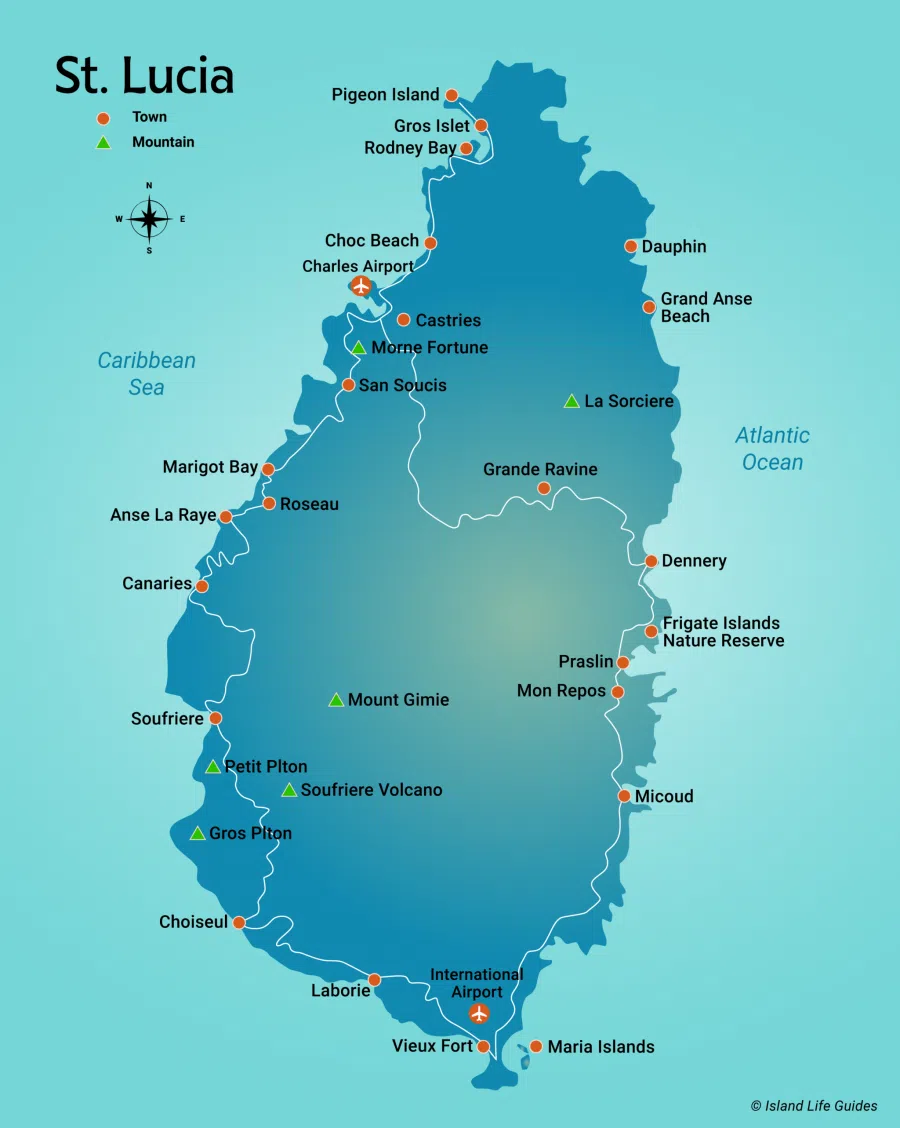
Saint Lucia on the Map: A Journey Through Its Rich History

Saint Lucia, a stunning island in the Caribbean, is often celebrated for its magnificent landscapes and vibrant culture. However, beyond the breathtaking views lies a tapestry of history woven with the threads of colonization, resistance, and resilience. To truly appreciate this beautiful gem, one must explore its extensive past. Knowing how Saint Lucia on the map has been shaped by various influences is essential for understanding its present-day identity.
As we embark on this journey through Saint Lucia's rich history, we will delve into its geographic overview, the early indigenous peoples, the tumultuous years of European colonization, the struggle for independence, and the cultural heritage that has emerged from this unique island. This exploration not only illuminates the historical significance of Saint Lucia but also highlights its evolution into a vibrant Caribbean nation that continues to captivate both locals and tourists alike.
- Geographic Overview of Saint Lucia
- The Indigenous Peoples: A Brief History
- European Colonization and Conflict
- The British-French Rivalry: A Turbulent Era
- The Path to Independence
- Cultural Heritage and Influences
- Key Historical Landmarks
- Notable Figures in Saint Lucia's History
- The Evolution of Saint Lucia's Society
- Conclusion: Reflecting on Saint Lucia's Rich Legacy
Geographic Overview of Saint Lucia
Saint Lucia is located in the eastern Caribbean Sea and is part of the Lesser Antilles archipelago. The island measures 27 miles in length and up to 14 miles in width, characterized by lush rainforests, volcanic peaks, and stunning beaches. The iconic Pitons, Gros Piton and Petit Piton, are two volcanic spires that rise dramatically from the sea, serving as a landmark for both locals and travelers. The capital city, Castries, is located on the northwest coast and acts as the primary port and commercial center.
Saint Lucia is bordered by the Caribbean Sea to the west and the Atlantic Ocean to the east. The island's strategic location has made it a critical point for maritime trade and defense throughout its history. The abundant natural resources and diverse ecosystems have not only attracted colonizers but also have played a vital role in the island's development.
The Indigenous Peoples: A Brief History
Before the arrival of European settlers, Saint Lucia was inhabited by the Arawaks and the Caribs. The Arawaks, who were the first inhabitants, arrived around 200-400 AD, bringing with them their agricultural practices and a rich cultural tradition. They were peaceful people who lived in small communities along the coast.
As time went on, the Caribs, a more aggressive group, migrated from the South American mainland and displaced the Arawaks in the 15th century. The Caribs established their presence on the island, and they are known for their warrior culture and resistance to foreign influence. Their arrival marked the beginning of a turbulent era for the indigenous peoples of Saint Lucia, as they faced the imminent threats from Europeans seeking new lands.
European Colonization and Conflict
The first European to arrive in Saint Lucia was Christopher Columbus in 1502; however, it wasn't until 1635 that the French established a settlement on the island. The French recognized the strategic importance of Saint Lucia on the map and began to cultivate crops such as sugar cane, which became a valuable commodity in Europe. They utilized both enslaved Africans and indentured laborers to work the plantations, leading to significant demographic changes and the ethnic diversification of the island.
The French presence was met with fierce resistance from the indigenous Caribs, who fought valiantly to protect their territory. This struggle continued for many years, as the island became a focal point of conflict between European powers in the Caribbean. The struggle for dominance would have lasting implications for the island's populations and their identities.
The British-French Rivalry: A Turbulent Era
The rivalry between the French and the British marked a transformative period for Saint Lucia. The British captured the island several times between the 18th and 19th centuries, elevating the intensity of conflict. The Treaty of Paris in 1763 gave the British control of the island; however, this control was short-lived, as the French took possession again in 1778 during the American Revolutionary War.
In 1814, the British regained control after the Napoleonic Wars and established it as a British colony. This back-and-forth exchange between the two powers profoundly affected the island's political landscape and social structure, influencing both its economy and the lives of its inhabitants.
The Path to Independence
After years of colonial rule, the people of Saint Lucia began to agitate for self-governance and independence during the mid-20th century. Political movements emerged, led by figures who sought to establish social and economic stability for their compatriots. The struggle for independence saw significant events, such as the establishment of a ministerial government in 1967 and the bilateral agreements with Great Britain.
Finally, on February 22, 1979, Saint Lucia gained independence from British rule, marking a new era for the island. The transition to self-governance was a cause for celebration, symbolizing the end of colonial dominance and the beginning of a journey toward nation-building.
Cultural Heritage and Influences
The rich tapestry of Saint Lucia's history is reflected in its diverse culture, which draws from African, French, British, and Indigenous influences. The island has a unique blend of languages, arts, music, and cuisine, which together create a vibrant cultural identity. Saint Lucia on the map is not just a geographical location but also a melting pot of traditions and practices.
Music is an integral part of the island's identity, with genres like calypso, soca, and reggae echoing through the streets during festivals and events. The island’s heritage is also celebrated through the annual Saint Lucia Jazz Festival, attracting international artists and showcasing local talent.
Key Historical Landmarks
As visitors explore Saint Lucia, they will encounter numerous historical landmarks that reflect the island’s rich past. Notable sites include:
- Fort Rodney: Located on Pigeon Island, this fort offers breathtaking views and a glimpse into the island's military history.
- The Pigeon Island National Landmark: A former naval base that features historic ruins, beautiful beaches, and a variety of flora and fauna.
- Morne Fortune: A hill overlooking Castries that was once used for military purposes, now serves as an important historical site.
- The Derek Walcott Theatre: Named after the Nobel Prize-winning poet, this venue hosts local performances and cultural events.
Notable Figures in Saint Lucia's History
Saint Lucia has produced many prominent figures whose impact on the island's culture and politics continues to resonate. One such notable person is Sir Arthur Lewis, an economist and Nobel Laureate, who made significant contributions to socioeconomic development in the Caribbean. His work has influenced policymakers worldwide and remains a cornerstone of economic thought in the region.
Another influential figure is the poet and playwright Derek Walcott, whose literary achievements have placed Saint Lucia on the cultural map. His profound works reflect the island's beauty and complexities, inspiring future generations of writers and artists.
The Evolution of Saint Lucia's Society
Over the years, Saint Lucia's society has evolved greatly, transitioning from a colonial economy primarily focused on agriculture to a diverse economy that includes tourism, services, and agriculture. While the historical threads of colonization remain significant, contemporary Saint Lucians celebrate their unique identity through various cultural expressions, community events, and advancements in technology and education.
Today, Saint Lucia's economy heavily relies on tourism, with visitors drawn to its natural beauty, rich heritage, and warm hospitality. Various initiatives have been undertaken to promote sustainable tourism while preserving the island's unique ecosystems and cultural heritage.
Conclusion: Reflecting on Saint Lucia's Rich Legacy
In conclusion, understanding Saint Lucia on the map entails delving deeper into its rich history filled with unique experiences, complex challenges, and vibrant cultural influences. From the indigenous peoples who first called the island home to the struggles against colonization and the journey to independence, Saint Lucia’s past is a testament to resilience and transformation.
As we reflect on the contributions of key historical figures, landmarks, and the evolution of society, we gain a broader appreciation for the island's legacy. Saint Lucia is more than just a location; it is a rich cultural tapestry that continues to shape the lives of its inhabitants and inspire those who visit. The journey through its history serves as a reminder of the importance of preserving cultural heritage while embracing a hopeful future.
Did you find this article helpful? Saint Lucia on the Map: A Journey Through Its Rich History See more here Education.
Leave a Reply






Related posts